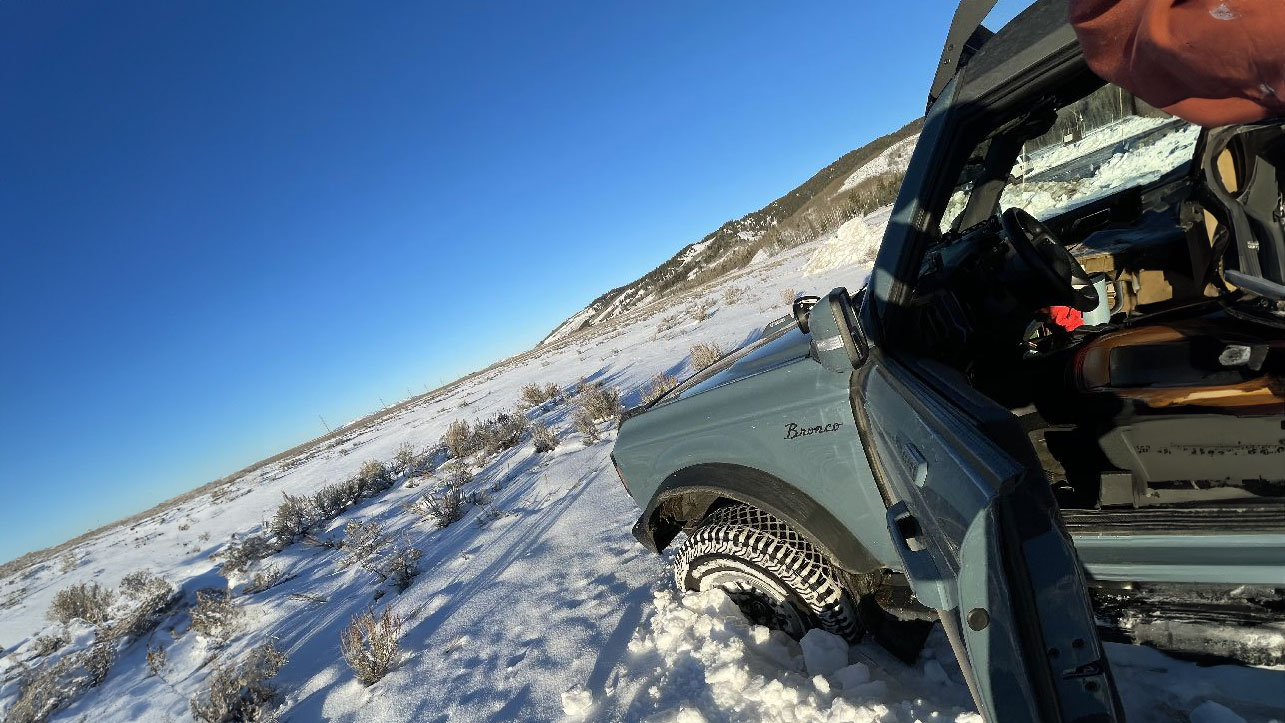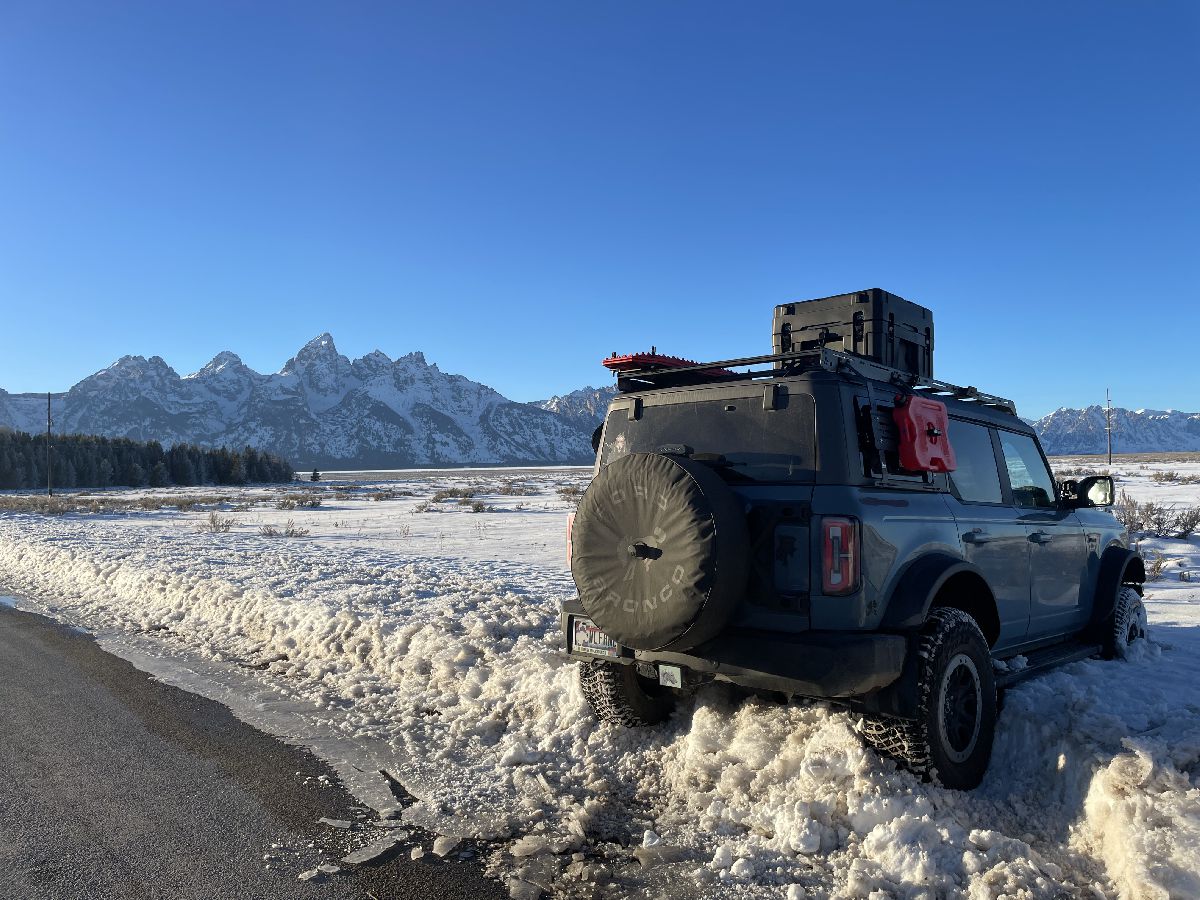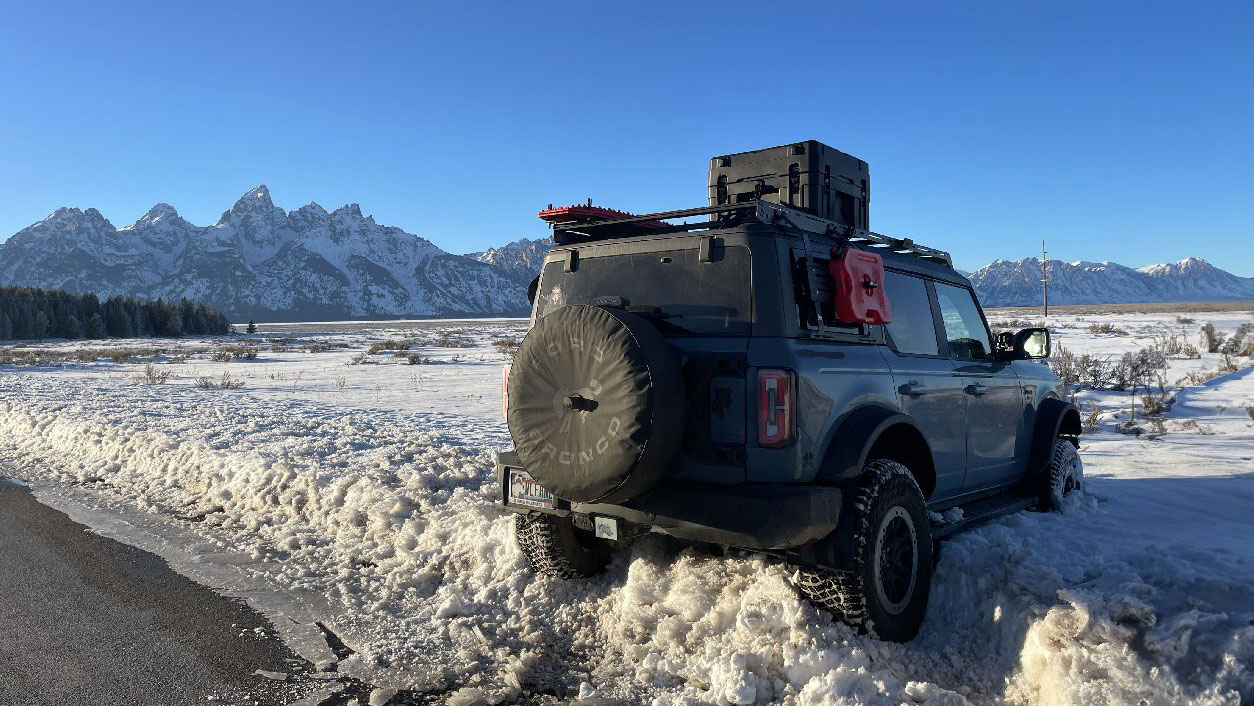Wednesday, January 31st, 2024, at 6:29 p.m. (MT), we received a request for help with an offroad recovery in Wyoming near Grand Teton National Park. The requester, Anna Morris, contacted us on our emergency line (503-877-5263), immediately after she submitted the request using our system: “Just barely off of the payment high centered in snow. Been digging for three hours but vehicle isn’t wanting to budge. / I’m with the vehicle.“
We prepared the request and submitted it to local volunteers within a 60-mile radius. Anna was asking for help, if possible, that same evening. We also suggested Anna deflate the tires to gain traction, but that didn’t help.


Within the first minute after submitting the request to volunteers, we had Jade Parker, a volunteer who was 2.5 hours away, marking himself as “standing by”
A bit later, Anna confirmed she was okay with spending the night in her vehicle. With that said, Jade was set to be the one helping in the morning. We had Jade and Anna in contact, and in the morning, Jade started driving, and he was halfway to Anna. A passerby got her unstuck.

We are happy Anna found help. But also we are very grateful for Jade’s willingness to drive the distance and help as well. That’s an awesome example of great voluntarism. Thanks, Jade. (offroad recovery in Wyoming)
In remote places like this one, we always need more volunteers; if you would like to receive a text message when we get a request near you, create your account here: offroadportal.org/signup
Unveiling Wyoming’s Hidden Gems:
Off-Roading Near the Great Tetons
Nestled within the rugged terrain of Wyoming lies a paradise for off-road enthusiasts: the Great Tetons. While this majestic mountain range is renowned for its stunning vistas and outdoor recreational opportunities, its lesser-known off-roading trails offer adventurers a chance to immerse themselves in unparalleled natural beauty. In this blog post, we’ll uncover some of the best areas to explore off-roading near the Great Tetons, promising adrenaline-pumping experiences and breathtaking scenery at every turn.
![Grand Teton National Park is a United States National Park in northwestern Wyoming. At approximately 310,000 acres (480 sq mi; 130,000 ha; 1,300 km2), the park includes the major peaks of the 40-mile-long (64 km) Teton Range as well as most of the northern sections of the valley known as Jackson Hole. It is only 10 miles (16 km) south of Yellowstone National Park, to which it is connected by the National Park Service-managed John D. Rockefeller, Jr. Memorial Parkway. Along with surrounding National Forests, these three protected areas constitute the almost 18,000,000-acre (7,300,000 ha) Greater Yellowstone Ecosystem, one of the largest intact mid-latitude temperate ecosystems in the world. Human history of the Grand Teton region dates back at least 11,000 years, when the first nomadic hunter-gatherer Paleo-Indians began migrating into the region during warmer months pursuing food and supplies. In the early 19th century, the first White explorers encountered the eastern Shoshone natives. Between 1810 and 1840, the region attracted fur trading companies that vied for control of the lucrative beaver pelt trade. U.S. Government expeditions to the region commenced in the mid-19th century as an offshoot of exploration in Yellowstone, with the first permanent white settlers in Jackson Hole arriving in the 1880s. Efforts to preserve the region as a national park commenced in the late 19th century, and in 1929 Grand Teton National Park was established, protecting the major peaks of the Teton Range. The valley of Jackson Hole remained in private ownership until the 1930s, when conservationists led by John D. Rockefeller, Jr. began purchasing land in Jackson Hole to be added to the existing national park. Against public opinion and with repeated Congressional efforts to repeal the measures, much of Jackson Hole was set aside for protection as Jackson Hole National Monument in 1943. The monument was abolished in 1950 and most of the monument land was added to Grand Teton National Park. Grand Teton National Park is named for Grand Teton, the tallest mountain in the Teton Range. The naming of the mountains is attributed to early 19th-century French-speaking trappers—les trois tétons (the three teats) was later anglicized and shortened to Tetons. At 13,775 feet (4,199 m), Grand Teton abruptly rises more than 7,000 feet (2,100 m) above Jackson Hole, almost 850 feet (260 m) higher than Mount Owen, the second-highest summit in the range. The park has numerous lakes, including 15-mile-long (24 km) Jackson Lake as well as streams of varying length and the upper main stem of the Snake River. Though in a state of recession, a dozen small glaciers persist at the higher elevations near the highest peaks in the range. Some of the rocks in the park are the oldest found in any U.S. National Park and have been dated at nearly 2.7 billion years. Grand Teton National Park is an almost pristine ecosystem and the same species of flora and fauna that have existed since prehistoric times can still be found there. More than 1,000 species of vascular plants, dozens of species of mammals, 300 species of birds, more than a dozen fish species and a few species of reptiles and amphibians exist. Due to various changes in the ecosystem, some of them human-induced, efforts have been made to provide enhanced protection to some species of native fish and the increasingly threatened whitebark pine. Grand Teton National Park is a popular destination for mountaineering, hiking, fishing and other forms of recreation. There are more than 1,000 drive-in campsites and over 200 miles (320 km) of hiking trails that provide access to backcountry camping areas. Noted for world-renowned trout fishing, the park is one of the few places to catch Snake River fine-spotted cutthroat trout. Grand Teton has several National Park Service-run visitor centers, and privately operated concessions for motels, lodges, gas stations and marinas.
[source: en.wikipedia.org/wiki/Grand_Teton_National_Park]
Website: www.nps.gov/grte/index.htm](https://offroadportal.org/wp-content/uploads/2024/02/36034795121_e18c3f4542_k-1250x834.jpg)
Gros Ventre Wilderness Area:
Located just east of the Grand Tetons, the Gros Ventre Wilderness Area boasts a network of challenging off-road trails. From scenic drives along the Gros Ventre River to rugged routes through alpine meadows, this area offers a diverse range of terrain to explore. Keep an eye out for wildlife such as elk, moose, and bighorn sheep as you navigate through this pristine wilderness.
Shadow Mountain:
Rising to an elevation of over 8,000 feet, Shadow Mountain offers off-roaders panoramic views of the Teton Range and Jackson Hole valley below. Accessible via the Shadow Mountain Trail, this area provides both beginner-friendly routes and more advanced challenges for seasoned adventurers. Be prepared for steep inclines, rocky terrain, and the possibility of encountering snow, especially in the shoulder seasons.
Antelope Flats:
Situated just north of the Grand Tetons, Antelope Flats is a haven for off-roaders seeking a more leisurely driving experience. Traverse the flat, open landscape as you soak in views of iconic landmarks such as the Moulton Barns and the T.A. Moulton Homestead. Keep your camera handy to capture glimpses of bison herds and pronghorn antelope roaming the grasslands.
Granite Hot Springs:
For off-roaders looking to unwind after a day on the trails, Granite Hot Springs offers the perfect opportunity to relax and rejuvenate. Accessible via a scenic dirt road south of Jackson, this natural hot spring is nestled amidst the Bridger-Teton National Forest. After a refreshing soak in the mineral-rich waters, you’ll be ready to tackle more off-road adventures with renewed energy.
Teton Pass:
For those craving a more adrenaline-fueled experience, Teton Pass delivers thrills aplenty. Located along the Teton Range west of Jackson, this mountain pass offers challenging off-road trails with steep grades and switchbacks. Test your driving skills as you navigate through rocky terrain and tight turns, all while enjoying breathtaking views of the surrounding peaks.
Before embarking on any off-road adventure near the Great Tetons, it’s essential to prioritize safety and respect for the environment. Be sure to check weather conditions and trail statuses beforehand, pack essential gear such as maps, navigation tools, and emergency supplies, and always tread lightly to minimize impact on fragile ecosystems.
The Great Tetons and its surrounding areas offer off-roading enthusiasts a playground of unparalleled beauty and adventure. Whether you’re seeking scenic drives through pristine wilderness or heart-pounding challenges along rugged mountain trails, Wyoming’s hidden gems await exploration. So rev up your engines, buckle up, and get ready to embark on the off-road journey of a lifetime amidst the awe-inspiring landscapes of the Great Tetons.


